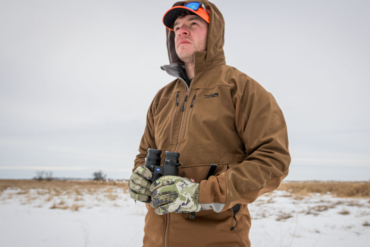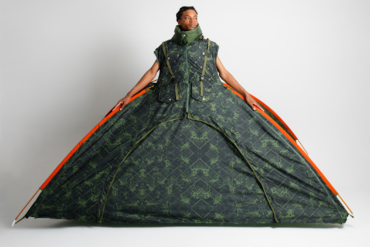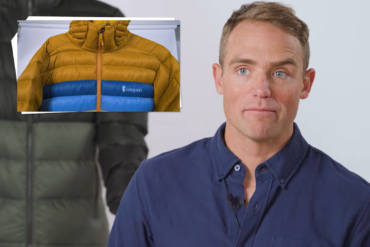Gore-Tex is a name synonymous with waterproof-breathable jackets. But if you’ve wondered What does Gore-Tex actually do? … this Explainer is a good place to start.

In 1969, Bob Gore was experimenting with a chemical compound called polytetrafluoroethylene by rapidly heat-stretching the polymer. Rather than snapping, the material unexpectedly stretched 800%, forming billions of micropores per square inch, each about 1/20,000 the size of a water droplet but 700 times the size of water vapor.
Turns out, the porous structure blocked water but allowed vapor to pass through. The invention, patented as Gore-Tex by W. L. Gore and Associates, became a juggernaut and standard in the outdoor market, popularizing a whole new category of jackets called waterproof/breathable (they keep water drops out, including rain and snow, but let vapor from sweat escape from the inside).
With booming popularity over many decades, the name Gore-Tex became synonymous with waterproof/breathable as many new players entered the field. Even today, the Gore-Tex brand is often used to refer to waterproof/breathable jackets in the same way Kleenex refers to facial tissue.

These days Gore-Tex is far from alone. A surge of other products by Polartec, eVent, Pertex, and more, have come into the market to offer waterproof/breathable options. Standards are determined by independent and in-house labs.
Waterproof Breathable
Most waterproof/breathable fabrics are somewhat fragile membrane material. They are sandwiched between an inner layer that faces the wearer, and an outer layer that protects the laminate. The outer layer, known as a “face fabric” usually is treated with a durable water repellent (DWR) chemical that forms beads and keeps the outside of the jacket from getting saturated, which is known as “wetting out.”

The result is a jacket that beads water on the outside. The internal waterproof membrane halts the progress of any water that gets past the outer fabric. Even if the beading fails (and it does as the DWR wears away over time and with abuse), the internal membrane keeps the wearer dry.
Different thicknesses of membranes are bonded to a variety of nylon and poly fabrics to provide a wide range of product durability and breathability. Regardless of thickness or materials, these products have similar goals of keeping the user dry.
Most reputable brands uphold meticulous standards. They have seams taped so water cannot get through holes caused by sewing through the waterproof membrane. All Gore-Tex products are seam taped and are “Guaranteed to keep you dry” for the useful life of the garment. Other brands carry their own warranties, and most are also very effective in their intended circumstance.
Waterproof/Breathable Limitations
But the Achilles Heal of waterproof/breathable fabrics comes not from the outdoors, but from the warm body ensconced within. The problem is sweat.

As people sweat during vigorous workouts it can easily overwhelm the ability of the membrane to carry water vapor through the shell. Over time, the water vapor builds up, sometimes pooling inside the shell due to condensation against the fabric. Especially in humid climates, the breathability of the fabric just can’t keep up with moisture produced by hard-working outdoors folks.
Many shells thus incorporate vents — commonly in the armpits or chest — to help athletes “dump heat” and free moisture to avoid becoming waterlogged from within.
While shells made from waterproof/breathable materials can be excellent performers, wearers still need to manage their heat, and moisture output, to keep dry. These shells are a tool, not a fix-all solution to moisture management.
Waterproof/Breathable Fabrics, Quantified
Gore-Tex is no longer the only game in town. To compare the performance of one brand to another, these measures quantify waterproofness and breathability in the lab.
- Hydrostatic head is the measurement of a material’s waterproofness. It measures in mm how tall a 1-inch2 column of water must be to breach the material. We recommend a minimum waterproof rating of 5,000mm to be considered truly waterproof.
- Moisture Vapor Transmission Rate (MVTR) measures the rate at which moisture moves across the material in grams/meter/day. We recommend looking for an MVTR rating of 10,000 or higher for more active pursuits.
- Resistance to Evaporative Heat Transfer (RET) measures how breathable a garment is, with lower being better for more aerobic activities. Gore-Tex Pro has a RET of less than 6; Gore-Tex Active, which is more breathable, is less than 3 RET.
Next Evolution? ‘Permanent Beading Surface’
In the last year, Columbia Sportswear and Gore introduced a new technology called a Permanent Beading Surface. These waterproof, breathable fabrics have durable construction and are made to be applied directly against the weather as opposed to behind a face fabric.

These new materials are changing the look and feel of apparel. With no need for traditional face fabrics, some jackets constructed with permanent beading surfaces have seam tape on the outside. They allow for new engineering methods, and we expect to see many adaptations soon.
Having tested a few jackets with permanent beading surfaces, we suspect they will catalyze a revolution in outerwear over the coming years. For adventurers, who spend a lot of time in the wet and cold, it’s an exciting development and one to watch closely.
Waterproof/breathable fabrics are an important tool in the outdoors toolbox. They help keep you dry and can move some sweat away from the body. They can be overwhelmed by aerobic activity, but are a common way to block wind and moisture, and they have proven useful — if not life-saving — for weekend hikes to mountain ascents and adventures around the world.








